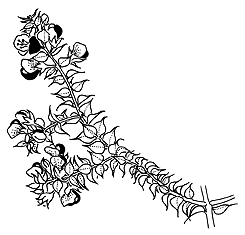Common name: Spiny Bush-pea, Grey Bush-pea
Pultenaea spinosa (DC.) H.B.Will. APNI* Synonyms: Spadostyles ternata F.Muell. ex Hannaford APNI*

Description: Procumbent to erect shrub; stems glabrous spreading-pubescent.
Leaves alternate, opposite or in whorls of 3, ovate to broad rhombic, flat to concave, 9–15 mm long, 9–25 mm wide, apex aristate, margins flat, surfaces usually concolorous; stipules 1–2.5 mm long.
Inflorescences subterminal, lax, leafy; bracts absent. Flowers 7–15 mm long; pedicels 3–7 mm long; bracteoles 2–5 mm long, lacking stipules, linear to linear-ovate, bristly to acuminate, glabrous to rarely ciliate, attached at base or lower part of calyx tube. Calyx up to 4–8 mm long, glabrous to moderately hairy; teeth acute to acuminate. Ovary glabrous or with a tuft of hairs at the apex.
Pods 5–7 mm long, turgid.
Distribution and occurrence: Widespread west to Warrumbungle Mountains, though the typical form appears to be restricted to the Hunter Valley region. Grows in dry sclerophyll forest on sandy or rocky soil.
NSW subdivisions: NC, CC, SC, NT, CT, ST, NWS, CWS, SWS
Other Australian states: Qld
P. spinosa is a geographically variable complex of apparently intergrading populations that previously had been split into 3 species [see Flora of NSW (1991)]. Currently under revision.
Text by P.H. Weston & R.P.J. de Kok, updated by R.L.Barrett, Sept. 2023
Taxon concept: Flora of NSW 2 (1991); updated revised NSW 2 (2002)
APNI* Provides a link to the Australian Plant Name Index (hosted by the Australian National Botanic Gardens) for comprehensive bibliographic data
***The AVH map option provides a detailed interactive Australia wide distribution map drawn from collections held by all major Australian herbaria participating in the Australian Virtual Herbarium project.
|


